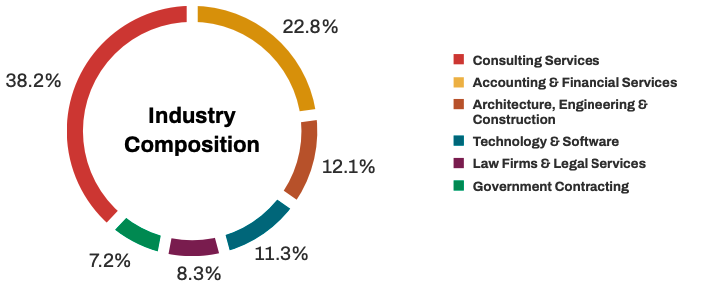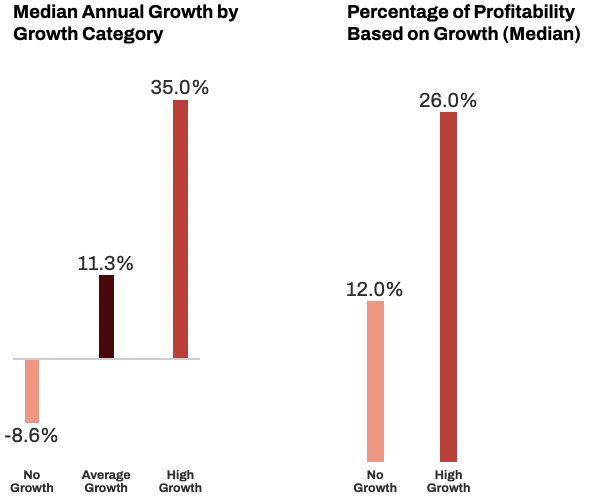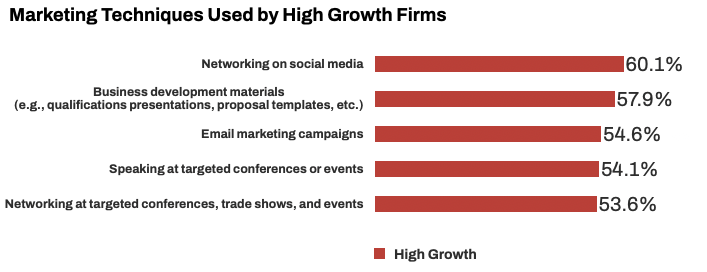This year, we released the ninth edition of our High Growth Study, including a special breakout report focused on the consulting services industry. Today, we’d like to share a few highlights from that report—findings marketers and executives at consulting firms may find useful as they try to make sense of the marketplace and plan for the future.
Speaking of the marketplace—for four years running, unpredictability and uncertainty have been the top concern of firms across industry. You don’t have to look hard to understand why. Global wars, a polarized political environment, an upcoming election like no other and mixed economic signals are just a few reasons firms are viewing the future with caution.
But beneath the gloom is a lot of hope. The industry has accelerated its growth each of the past three years. And the larger economy has continued to expand, offering the possibility that consulting businesses will continue to prosper.
At the same time, artificial intelligence made huge strides forward as ChapGPT, Gemini (formerly Bard) and other generative AI technologies burst on the scene. Despite its current limitations, nobody doubts AI’s potential—and firms, as well as their clients, are eager to harness the technology’s efficiencies and analytical power.
In this year’s study, we focus on that subset of firms that grows 3X faster and is 2X more profitable than their slower growing counterparts. Before we dive into the study’s highlights, however, let’s learn a bit about the study and the High Growth firms that have so much to teach us.
About the Study
442 consulting services firms participated in this year’s High Growth Study, representing $13.5 billion in combined revenue and almost 97,000 employees. This was the largest industry sample in the study (see figure below).

Study participants represent firms of all sizes. They conduct business in six continents.
In the study, we grouped the participating firms into three categories: High Growth (see definition in the section below), No Growth (those that experienced zero or negative growth), and Average Growth (the balance of the sample).
Meet the High Growth Firms
We define High Growth firms as those firms that achieve at least 20% compound annual growth over a three-year evaluation period. We contrast these firms against those that experienced little or no growth over the same time frame. This allows us to identify strategies and practices that are associated with faster growth and higher profits.
This year’s High Growth consulting firms grew at a median rate of 35%—more than three times faster than average.
High Growth firms are also more profitable than their slower-growing competitors. High Growth firms enjoyed a profit of 26%—more than twice the rate of the No Growth group.

Next, we look at five key factors that give these firms a competitive advantage.
1: High Growth Firms Don’t Spend More on Marketing
High Growth firms spend the same amount on marketing as their No Growth peers—10% of revenues, not including personnel compensation costs. Yet they achieve far superior performance. If the amount you invest in marketing your services isn’t correlated with success, what is? For one thing, these firms are more efficient. For instance, they are more advanced in their adoption and use of technology. At the same time, these firms know where to spend their limited marketing dollars most effectively.

2: High Growth Firms Know What Works
Below are the five marketing techniques used most often by High Growth firms. At the top of the list is networking on social media—primarily LinkedIn. LinkedIn is a great place to connect with new prospects, meet potential strategic partners, share valuable content and demonstrate your expertise. And it costs little more than your time. Top firms also invest in high-quality business development materials. These might include pitch decks, qualifications packages and proposal templates. Email marketing remains the best way to nurture the prospects on your list, and High Growth firms often use it to share highly relevant content and offers with their audiences.
Public speaking is a time-tested way to build visibility and credibility, while giving audiences a taste of what it might be like to work with you. It’s also a great way to put a personal face on your brand. And networking at live events provides valuable face-to-face interaction with prospective clients. While this was once the primary way consultants developed new business, live networking is now just part of a larger integrated marketing strategy.

In the full consulting industry report, you can access the full list for this and other charts in this post. We also dive into which techniques provide the greatest impact, as well which provide the most impact for fewest dollars and hours spent.
3: They Are More Likely to Conduct Research
The High Growth cohort was more likely than the No Growth group to conduct formal research on their target audience. Regular research gives firms the ability to understand the changing habits, preferences and needs of their buyers.
That said, more than 6 in 10 High Growth firms do no research. We see this as a big miss, especially in uncertain times when the marketplace is particularly hard to read.

4: High Growth Firms Outsource More Marketing Skills
One way the High Growth contingent creates efficiencies in their marketing is by outsourcing a wide variety of specialized skills. And they do it much more often than No Growth firms.
What are the advantages of outsourcing skills? First, you usually will spend less for them, as you only pay for what you need. Second, specialists are true experts in the skill you need, and they use the latest tools and techniques. That means they will do it better than any generalist. Third, they are more likely to get results. Depending on the activity, they may even have the metrics to prove it.
The top five outsourced skills are website improvements, graphic design and marketing materials development, search engine optimization and video production. Firms that try to do these things in-house typically end up with amateurish output and little to show for their investment.

5: They Are Looking Forward
We asked study participants what topics and trends they wanted to learn about this year. We ask this question because it gives us insight into where firms—and most interestingly, High Growth firms—are focusing their attention. It’s a way of understanding where they are steering their boats.
Not surprisingly, artificial intelligence surged to the top of the list. AI, despite its well-publicized problems, is here to stay, and it will increasingly become an essential part of our tools and workflows as time goes on. Strategy came in second. Firms that want to remain competitive understand that strategy is where it all begins. And no strategy is ever set in stone. As the marketplace evolves, strategy has to change, and the top performers know it.
Deepening online engagement was last year’s list topper. This year it has dipped into third place. But tomorrow’s buyers aren’t going to abandon Google, social media and other digital platforms any time soon. If anything, they will rely on these tools even more to find and evaluate professional services firms. High Growth firms want to be where their audiences will find them, and they want to hold their attention.
We mentioned earlier that High Growth firms were more digitally mature than their slower-growing counterparts. That doesn’t mean they are resting on their laurels. They are continuing to invest in their digital transformation, and as AI becomes more essential to their competitive advantage we expect this trend to accelerate. Finally, High Growth firms understand they are service providers, and most rely on repeat business to sustain their growth. As a result, they are looking for new ways to impress their clients and build longer, more satisfying relationships.

Market Your Firm the High Growth Way
High Growth firms have learned the hard way how to build a marketing program that delivers amazing growth and profitability year after year. The good news is that you can, too. Using the data in this year’s High Growth Study you can emulate these high flyers.
Start by looking at the data and comparing it to your own marketing program. Where are the similarities, and where are the differences? What can you implement and test quickly, and what might take a bigger investment of time and money? Look not only at what these firms are doing now, but what they are planning to do in the future.
This is the same data we use to inform the advice we give our own clients, and we’ve witnessed many remarkable results when we apply the lessons we’ve learned from the industry’s best performers to consulting firms like yours. To learn more, you can purchase the full industry report. Or you can reach out to Hinge for hands-on guidance and support.



